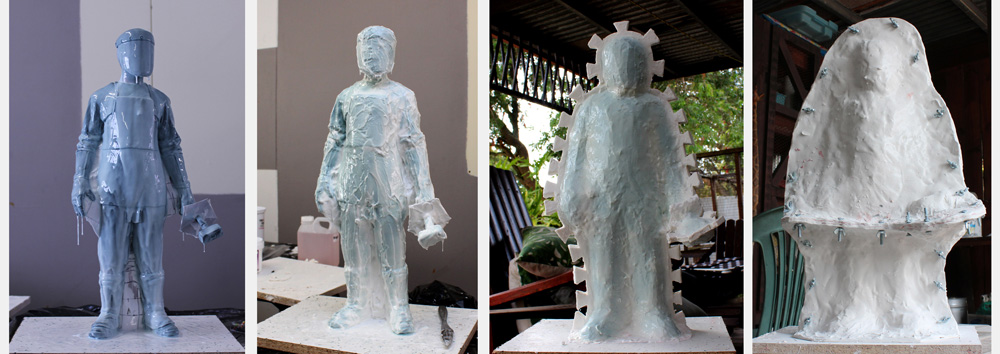
Jonathan van der Walt is a fine artist based in Port Elizabeth, South Africa, focusing his practice in the discipline of sculpture.
In 2013 he received his Bachelors degree cum laude in Fine Art (Sculpture), in which he explored the blurred lines between high and low art within contemporary society and became the launching pad for research into craftsmanship in contemporary art, which was the major theme in his Masters of Fine Art (Sculpture) completed in April 2017.
We asked him some questions about work, life and his studio at Nelson Mandela University in Port Elizabeth.
Hi Jonathan, tell us a bit about yourself - what’s your background?
I was born in Kimberley, Northern Cape in 1991 and moved to Port Elizabeth in 2000. As a child I always had a great interest in art. After school I registered for Visual Arts at Nelson Mandela University in 2010 thinking I would focus towards a degree in painting/drawing or even Graphic Design but fell in love with sculpture.
How many years an artist?
About 8 years as a professional artist, considering the sale of my first artwork as the start of my professional art career.
Bronze casting - Photography by Darryn van der Walt
What does your work aim to say?
In 2017 I released a body of work, entitled ‘The Art of Making It’, which was the practical component to my Masters dissertation. That series of sculptures explored the artistic production processes of selected contemporary artists’ work, revealing a tendency of physical non-involvement on the part of the artist, who, in some cases, took up the role of an art director in charge of hundreds of assistants. Contemporary art, for the most part, is a collaborative process, all parties involved in a collaboration benefit in their own specific ways, and the artist’s primary role within the collaborative process is to provide the artistic idea. A lot of my work attempts to provide transparency of that fact, highlighting the importance of the craftsperson/craftspeople that make many artists’ ideas come to life.
More recently, my post-masters practice is exciting in its simplicity in that I am merely sculpting people in places.
What should people know about your art that they can’t tell from looking at it?
My sculptures are multi-layered, and although there might be a core theme, or concept, I often try to include subtle symbolic hints to more, such as nods to other artists or pop-culture references. I like to have fun in conceptualizing an artwork, by adding something tongue-in-cheek or sometimes appropriating an existing artwork or artist.
Patina of the Craftsman in the foundry and working with David Jones
Which living or dead artist would you most like to meet?
A difficult question … I’ll provide both a living and a dead one ??
An alive Michelangelo would be great to have a chat with I think. A superb craftsman and a true Renaissance man.
A contemporary sculptor that I feel I could learn a lot from is Ron Mueck. Not only for his hyper-realistic modeling of his sculptures, but also his experience and knowledge in the moulding and casting processes as he prefers to work through the stages alone as much as possible, which is highly admirable considering the scale and detail of some of his pieces.
Tell us about your studio. Location, clean, cluttered, big, small, etc?
As a sculptor, you always yearn for more space. Creating a new work requires the space for the following: drawing/sketching (clean), armature building (messy), wax/clay modelling (messy or clean), mould-making (messy), resin casting (very messy), working off and finishing (very messy) and mounting (clean). So, as you’ll note, it is very difficult to be a clean sculptor. I have a clean space and a messy space and I work in phases, so I make a lot of mess (sometimes also in the clean space) for a period of time, and then have a clean up day or two, and start again. I share a studio/work space with my partner and fellow sculptor, Sarah Walmsley, which is located behind the Nelson Mandela University’s Bird Street Gallery.
Do you prefer to work with music or in silence?
When I am working in the clean space I prefer to work with music but find it tricky to have music in the messy space. You can very easily coat your technology in fiberglass resin ??
Where can we find you outside of the studio?
I am currently employed by the Nelson Mandela University as the intern gallery manager for their Bird Street Gallery and have been since 2017. So therefore, having a workspace on the property as well, it is very hard to find me anywhere else. To keep me busy, I enjoy swimming, and to relax, I do enjoy company with friends and family around a braai.
What materials couldn’t you live without?
With the type of sculptures I create, I think the most crucial material would be silicone rubber. I could always trade wax for clay in the modeling phase, and resin for a variety of casting mediums. But to translate that original form into the final product, the silicone rubber is essential.
Who are your biggest influences?I owe the majority of my interest in and love for sculpture to the mentorship of lecturer and sculptor David Jones. He has been and continues to be a large influence in establishing my artistic foundation, especially in emphasizing the importance of the technique, processes and craft behind the final product.
I have a great interest in figurative sculpture, and therefore I am inspired by the work and career of South African sculptor, Angus Taylor. The success and respect he has garnered both nationally and internationally is highly admirable.
How do you cultivate a collector base?I feel that the best way to build up a solid collector base is to keep making, and to stay up-to-date digitally, whether that’s through my website, emails or on social media pages.

Moulding stages of The Craftsman.
Which current art world trends are you following?
Part of my masters research involved the influence of 3D technologies, which has had a huge impact on the world of sculpture. It was very interesting exploring its use in the industry and how it can/is used as a medium or process in a final art piece, as it should be embraced as a tool, and not ignored.
If you could be any television or movie character, who would you be and why?
If I could just select the power of flight from Superman without all the other powers and responsibilities, that would be incredible! I love to travel and would love to see more. This way I can avoid all the costs involved as well as attend art exhibitions and fairs around the world (artist goals!)
3D Scanning of 'Striving For The Idea(L): Maurizo Cattelan'
What’s your go-to coffee order?
Cappuccino, sometimes double-shot depending on the day
If they made a movie about your life, who would play you and why?
Probably Damian Lewis, because of the pale skin, red hair and freckles
What does a typical day in your life look like?
A typical day involves a fruit smoothie for breakfast, a work day at the Bird Street Gallery (which is exciting as there is always something different going on each day), and then some personal artmaking in the studio after work. Depending on energy levels, either meet up with friends or family or relax at home playing PS4 :)
What does success look like to you?
Success for me is being in a position of a full-time artist with a supportive client/customer base. Being able to make a living off of just making and exhibiting my sculptures.
Favourite Artist to follow on Instagram?
One of my favourite artists to follow on Instagram is sculptor Nick Bibby (
@nickbibbysculpture). His attention to detail is phenomenal, but even more amazing is his understanding of armature building – the skeletal support for a sculpture. They are masterpieces.

